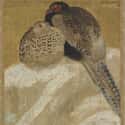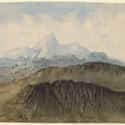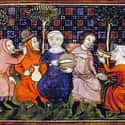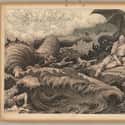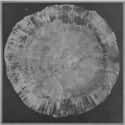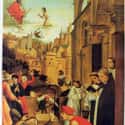-
(#4) Summer Snow Reportedly Fell In China And Mesopotamia
Around 536, the climate in China underwent some odd changes of its own. The Nan Shi, a 6th-century chronicle, reported a yellow ash-like substance falling from the sky. The exact composition of the material remains unclear, but accounts describe it as dirt or dust that could be "scooped up in handfuls." The substance appeared three times during the late 530s.
The following year, Chinese chronicles indicated snow during the summer months. The Chronicles of the Southern Dynasties reported frost in mid-summer with snow in August, which ruined crops in Qingzhou and other provinces. The result was widespread famine that lasted for about two years and resulted in a loss of roughly 70-80% of the population.
Additional reports of frost and snow in Mesopotamia also turned up during the summer of 536, and the winter was "a severe one, so much so that from the large and [unwanted] quantity of snow, the birds perished."
-
(#8) Subsequent Volcanic Eruptions Only Made Things Worse
Volcanic eruptions in Iceland in 540 and 547 contributed to the general darkness of the time. The three eruptions together led to what scholars termed the Late Antique Little Ice Age. This Little Ice Age cooled the planet for at least a decade, if not longer. The result was crop failure and starvation, which led to increasingly unhealthy populations susceptible to illness.
Based on tropical volcanic ash discovered in both northern and southern ice cores, some scholars posited a volcano in El Salvador in 535 or 536 kicked off the Little Ice Age. Near San Salvador, the Ilopango volcano - now a crater lake - erupted during the mid-6th century as well. The eruption coincided with the "Hiatus" period of the Mayan Empire, during which time the population and construction activity declined. Others believed the eruption of volcanoes in North America during the 530s brought on the massive cloud that hung in the skies over Northern and Western Europe.
Even if the Ilopango eruption, a North American volcano, or any other volcanic event was not singularly massive enough to blanket the Western hemisphere with ash, the events contributed to the overall darkness of mid-6th century.
-
(#6) Irish Chroniclers Describe Widespread Bread Shortages
Monks in Ireland during the 6th century took notice of the crop failures around them. The monastic tradition in Ireland, later dubbed Celtic monasticism, exhibited a love of scholarship. This prompted monks to not only copy existing manuscripts and preserve learning, but also keep records of the world around them. The unknown author of the Annals of Ulster recorded a "failure of bread" in 536, and his counterpart at Inisfallen indicated bread shortages from 536 to 539.
Ulster, in the northern part of Ireland, and Inisfallen, located in the south, were both in proximity to Iceland, where some experts posit a volcano triggered the fog of 536.
-
(#5) Scandinavians Abandoned Entire Cities
During the 6th century, villages in eastern and central parts of Sweden saw such decline that many cites were abandoned. The reason for this deserting remains somewhat unclear, but the "dust veil" of 536 and subsequent scarcity certainly influenced Scandinavians' actions.
Prior to the ice core evidence about the eruption of 536, theorists believe a possible meteor strike brought on such devastation. Additional evidence showed that village abandonment happened due to farmhouse fires, indicating relocation wasn't out of the question.
That said, a Norse legend called Fimbulwinter includes a three-year-long winter that occurred before Ragnorök, the end of the world also referred to as the Twilight of the Gods. It is possible the story of the extended winter became associated with the extended darkness present in this century.
-
(#12) Tree Rings Reveal How Much The Climate Impacted The Environment
The new ice core evidence presented by the 2018 study and others builds on evidence discovered by dendrochronologists during the 1990s. Dendrochronology uses a tree's rings to determine its age. According to a professor from the 2018 study, scientists first looked at rings from Icelandic trees and saw something significant had taken place during the mid-6th century. Tree growth slowed, indicating colder temperatures than usual. The new ice core evidence added specificity to those findings and helped trace the catastrophic event that kicked off massive change to the year 536.
Additional research shows that tree growth slowed around the world. In both North America and Europe, tree ring data indicates the world became considerably colder for at least 15 years after the 536 eruption. Between 536 and 545, world temperatures reached the lowest they had been in 2,000 years.
-
(#3) A Plague Swept Through The Byzantine Empire
The lingering cloud of dust was not the only issue that made 536 such a bad year. Procopius mentioned a pestilence that followed the darkness of 536, and Michael the Syrian wrote about the ruin that ran through the Byzantine Empire:
An unprecedented plague ensued which began in Constantinople where the first day 5,000 people [perished], the next day 10,000, the third 15,000, the fourth 18,000 - figures reported by the auditors that the emperor had placed at the gates of the city. They counted up to 300,000 people... and then left off counting.
No one was immune, as it "first attacked the poor class of the population, then the merchants and the nobility including the Imperial Palace." The symptoms "began with a [sore] that formed in the palm of the hand, and progressed until the afflicted one could not take a step. The legs swelled, then the buboes burst and pus came out."
The presence of the plague in Constantinople meant "the city began to stink [from the unburied] and so [they] were thrown into the sea, but the bodies kept resurfacing." The Emperor Justinian ordered [them] to be removed from the city, but "often the bearers themselves [were felled by disease] in the street. Furthermore, it even happened that someone would enter a deserted house and gather up its treasures to [take], but would end up [not making it out alive] at the door, on the way out."
Things became even worse in other parts of the empire, however:
The plague spread to Egypt where one city was wiped out [in this manner]: only seven men and a boy remained alive there. As they wandered around the city, suddenly the seven men [were felled] on the spot. Then the lad saw the angel of God in the guise of an old man. Seeing the child weeping, the angel removed him from the city and said: "Go now and weep not, for this punishment is the payment for heresy and sin."
What came to be called the Plague of Justinian took out millions of people in the Byzantine Empire between the early 540s and the mid-8th century.
New Random Displays Display All By Ranking
About This Tool
As we all know, thousands of people have been killed by COVID-19 in 2020, the wildfires in Australia lasted for several months and African locust plagues were raging. Many people believe that 2020 may be the worst year in human history. However, most historians agree the situation in 536 AD was worse than it is now. According to historical records and related research, the European volcanic eruption in 536 AD triggered chain reactions.
There was no sunlight for 18 months so that people could not distinguish between day and night, crops could not grow normally, and food production was reduced, which caused social chaos and a plague. The random tool shared 13 details about what happened in the worst year.
Our data comes from Ranker, If you want to participate in the ranking of items displayed on this page, please click here.











